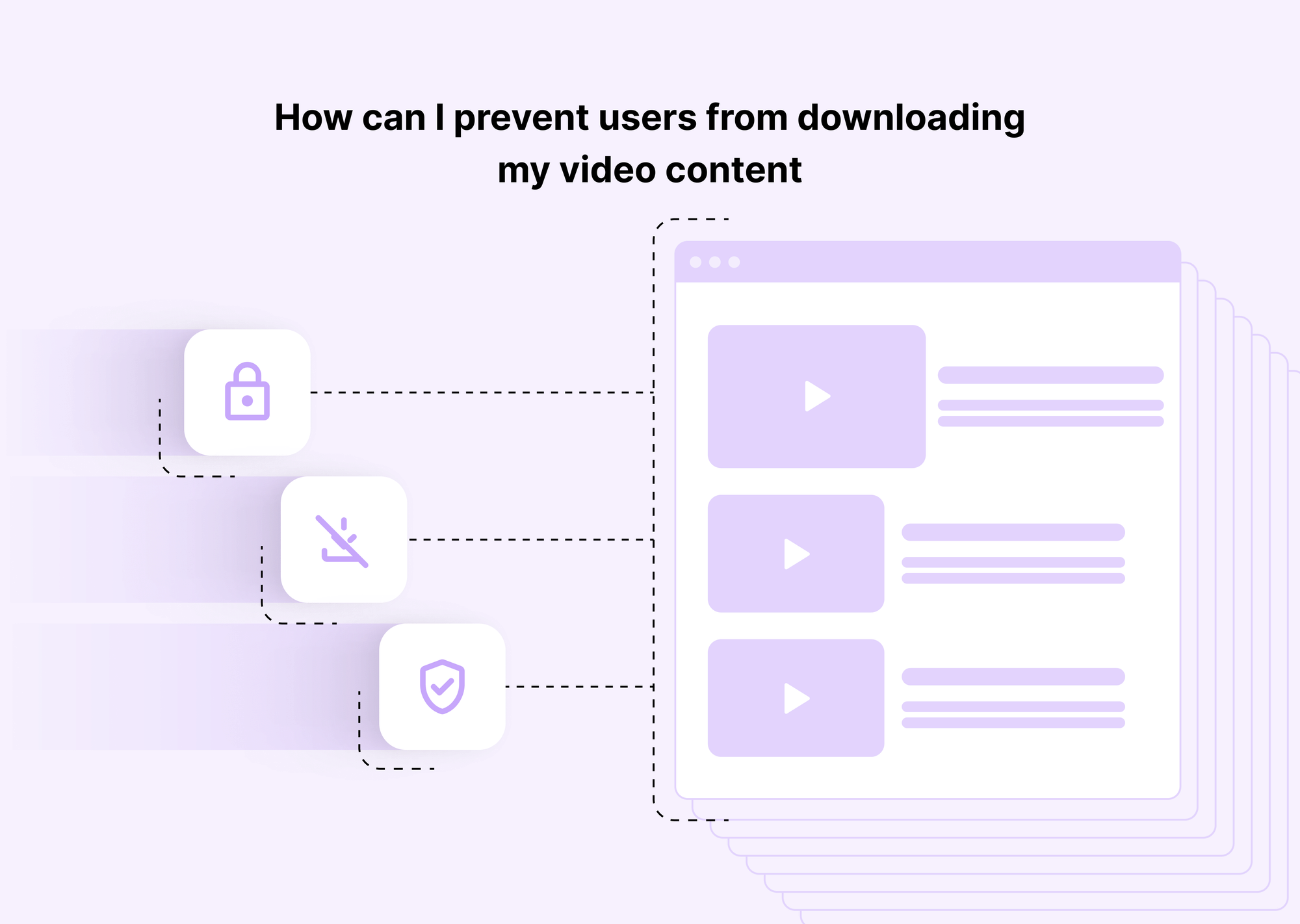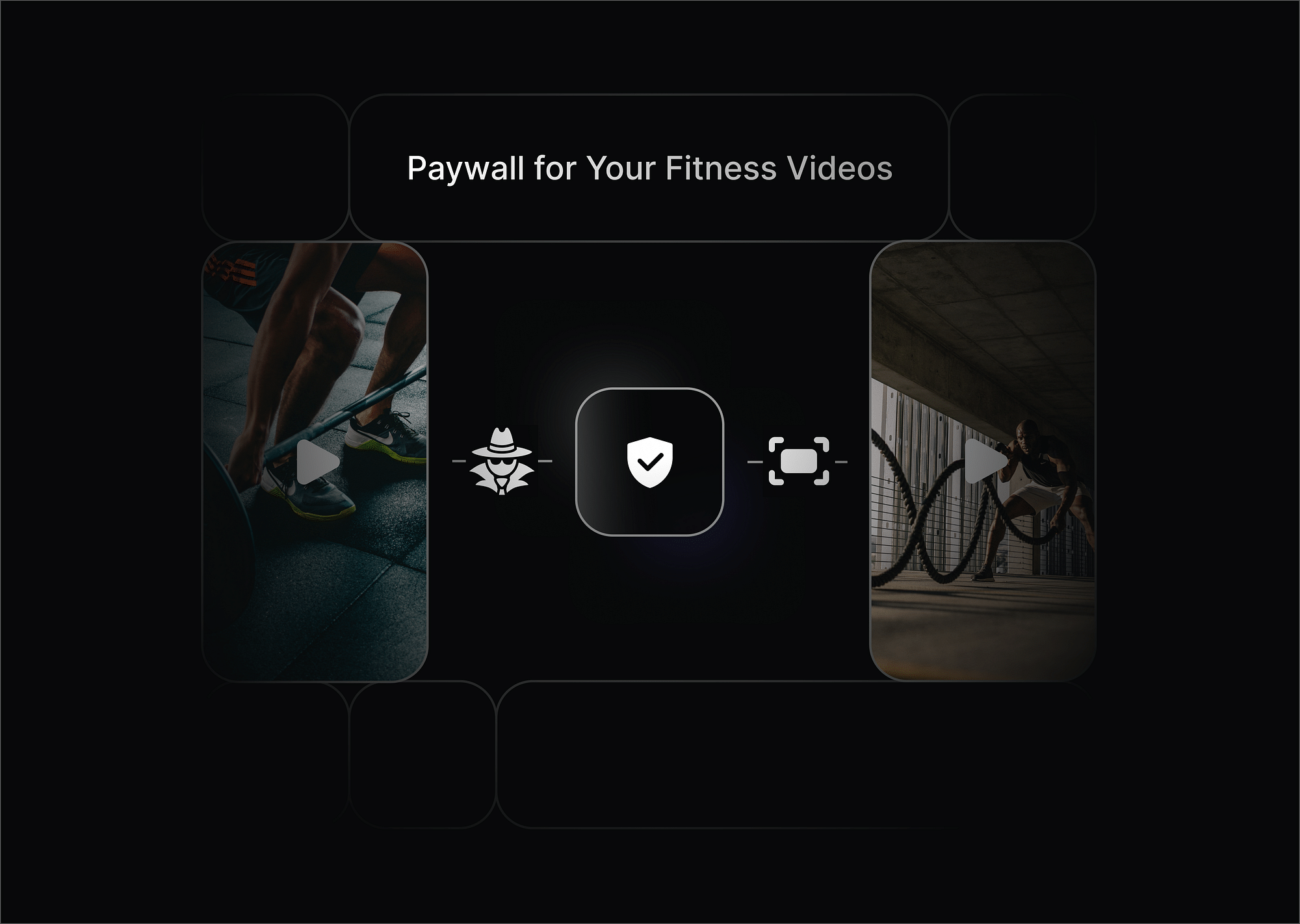The Short Answer
Short answer: You can’t entirely prevent downloads, but you can make piracy impractical, detectable, and expensive.
Every time a video is played, it can be copied via screen recording, network capture, or external devices. The real goal isn’t total prevention but deterrence: make piracy costly, risky, and traceable. Tricks like disabling right-click or hiding MP4 links might fool amateurs, but do nothing against professional piracy setups. Absolute protection needs a security stack. MUSO measured 229.4B piracy site visits in 2023, underscoring the scale of the problem
The Hard Truth (Read This First)
Simple rule of thumb to live by - if a device can play it, a device can copy it. Your job is to raise the cost and increase the risk for pirates.
No platform can stop video downloads completely. What you can do is reduce mass redistribution and ensure accountability. Think of it like seatbelts: they don’t make you immortal in a crash, but they dramatically reduce damage.
According to industry data, 84% of video publishers report piracy-related losses, and streaming piracy costs OTT and pay-TV services over $113 billion each year. That’s why you need layered defenses instead of quick fixes.
Security is a stack, not a switch: encrypt → authorize → watermark → monitor → enforce.
Steps That Actually Prevent Unauthorized Downloading of Your Videos
Modern video piracy is driven by automation. Bots scrape MP4s, share links, or re-upload content within minutes. To prevent video downloads from your website and make leaks traceable, you need layered protection. Below are the proven technical steps that strengthen your video content piracy security solution across streaming, licensing, and monitoring.
Use Adaptive Streaming, Not MP4 Downloads
Serve HLS/DASH segments—never progressive MP4 downloads.
Progressive MP4 files can be easily downloaded in one go, making them the weakest link in any online video hosting platform. In contrast, HLS (HTTP Live Streaming) and DASH (Dynamic Adaptive Streaming over HTTP) break videos into small, time-coded segments. Each segment is encrypted and delivered dynamically as the user watches.
This segmentation allows on-the-fly bitrate adaptation and prevents direct access to the entire file. Even if someone captures a few segments, they’re useless without decryption keys.
Encrypt Streams (AES-128 / CENC)
Encryption protects content in transit; DRM controls who gets a decryption license.
Encryption ensures your videos remain scrambled unless unlocked by authorized players. Most OTT video hosting workflows now use AES-128 or Common Encryption (CENC), with Bitmovin reporting that nearly 90% of OTT systems rely on AES encryption for streaming protection.
The encryption process typically follows this flow:
Server → Key Management Service (KMS) → DRM or playback license → Player
This ensures that even if pirates intercept video segments, the content remains unreadable without the corresponding encryption key.
Add DRM for License-Based Playback (Widevine, FairPlay, PlayReady)
Digital Rights Management (DRM) adds a layer of controlled licensing on top of encryption. Each playback request is validated by a DRM server that issues a unique decryption license to approved devices and browsers.
- Widevine: for Android, Chrome, and smart TVs
- FairPlay: for iOS, macOS, and Safari
- PlayReady: for Windows, Edge, and Xbox
Lock Access with Short-Lived, Signed URLs
Signed, short-lived URLs are non-negotiable for gated playback.
A signed URL adds a cryptographic signature and expiry time to each playback request. Once expired, the link becomes invalid—stopping users from reusing or sharing it.
This mechanism forms the core of secure video hosting workflows by ensuring each request is verified.
For example, a URL might include parameters like exp=timestamp and sig=hash. The player checks these before streaming begins, ensuring time-bound, verified access.
Whitelist Domains & Block Hotlinking
Hotlinking is one of the easiest ways pirates distribute content—embedding your hosted video on external sites.
By whitelisting domains, you ensure playback works only from your authorized websites or applications. Combine this with referrer and IP checks at the CDN or Nginx level to block third-party requests and unauthorized embeds. This approach drastically limits exposure on piracy forums or mirror sites.
Watermark Every Session (Forensic / Visible)
Forensic, session-specific watermarking is your post-leak evidence.
Dynamic watermarking embeds unique identifiers—such as {email_hash} or {timestamp}—into every playback session. These identifiers can be visible (onscreen overlays) or forensic (imperceptible digital patterns). When leaks occur, forensic marks enable tracing the source.
Limit Concurrency & Bind Sessions
Account sharing may seem harmless, but at scale, it leads to significant losses in paid video and online course piracy.
Implement concurrency limits—restrict the number of simultaneous streams per account—and bind each session to a specific device ID.
For inspiration, turn towards Netflix. Their 2023 password-sharing crackdown resulted in 5.9 million new signups, proving that session binding and enforcement directly reduce unauthorized access.
Monitor, Alert, and Enforce
Piracy prevention doesn’t end at delivery—it continues in monitoring.
Deploy tools that detect anomalies such as multiple IP logins, excessive playback attempts, or abnormal watch durations. Set up alerts and maintain DMCA-ready logs for rapid enforcement.
An effective monitoring setup includes dashboards showing license failures, token mismatches, or playback attempts from unknown regions. Once identified, these incidents can be escalated for takedown.
What Doesn’t Work (and Why)
When businesses or creators try to prevent video downloads from websites, they often fall for surface-level tricks that provide a false sense of security. These cosmetic solutions might block casual users, but do nothing against skilled pirates or automated bots. Absolute video content piracy protection requires encryption, DRM, watermarking, and monitoring, and not front-end hacks.
Here’s why standard methods fail:
- Disabling Right-Click: Turning off right-click may hide “Save As” options, but anyone can still open developer tools or use screen-recording software. Network sniffers and browser extensions easily capture MP4 links or cached video segments. This trick only stops beginners, not piracy.
- Obfuscated JavaScript: Minifying or encoding scripts doesn’t protect video URLs. Modern browsers allow anyone to view source code or inspect network activity. Pirates can easily deobfuscate JavaScript and extract your streaming endpoints within seconds, bypassing your attempts to prevent video download entirely.
- Hiding or Renaming MP4 Links: Renaming or nesting video files like “file001.mp4” doesn’t fool automated crawlers. Direct MP4 links remain vulnerable because they can be downloaded instantly once exposed. To truly stop video downloads, you must switch to HLS/DASH adaptive streaming and apply DRM-protected encryption.
- Iframe Walls & CSS Overlays: Some sites use transparent overlays or iframe layers to block user interactions. These are purely cosmetic defenses, and they don’t encrypt your stream or hide network requests. Pirates can still capture the raw media files directly from browser traffic. Without signed URLs or domain whitelisting, your video is fully exposed.
In short, none of these tricks constitutes a genuine video content piracy security solution. They only delay theft by minutes. Real protection for your online video hosting platform requires a multi-layered approach: encrypt, authorize, watermark, monitor, and enforce.
Step-by-Step: How to Prevent Users from Downloading Your Videos
Use this runbook-style guide to secure your video delivery pipeline and effectively prevent video downloads. Each step builds a layer of protection against video piracy, ensuring that your online video hosting platform enforces encryption, controls access, and maintains accountability.
Move to HLS/DASH Delivery
- Convert all progressive MP4 files into adaptive streaming formats (HLS or DASH).
- Segment each video into encrypted chunks.
- Serve only segmented streams, never direct MP4 files.
- This prevents bulk downloads and allows server-side playback control.
Enable Encryption with Server-Side Key Management
- Apply AES-128 or CENC encryption to all video segments.
- Store keys securely using a Key Management Service (KMS).
- Ensure keys are never visible in browser or client code.
- Encryption prevents intercepted data from being readable without authorization.
Add DRM Licenses for Each Platform
- Integrate Widevine (Chrome/Android), FairPlay (Safari/iOS), and PlayReady (Edge/Windows).
- Configure license servers to issue keys per user session.
- Ensure licenses are device- and browser-bound.
- DRM ensures only verified users can decrypt and play your content.
Issue Signed URLs with Short TTLs
- Generate signed URLs with HMAC and an expiry timestamp.
- Set time-to-live (TTL) to a few minutes per session.
- Validate signature and expiry before playback.
- Expired URLs automatically prevent unauthorized sharing.
Apply Dynamic/Session Watermarking
- Embed user- or session-specific watermark overlays in every stream.
- Use forensic watermarks for invisible identifiers and visible overlays for deterrence.
- Include details such as the email hash or timestamp in the watermark.
- This enables traceability in the event of leaks or online course piracy.
Enforce Domain Whitelisting & Referrer Checks
- Restrict playback to authorized domains or applications.
- Implement referrer validation at the CDN or player level.
- Block playback from unapproved sources or piracy sites.
- This prevents hotlinking and unauthorized embedding.
Set Concurrency Limits & Revoke Logic
- Limit concurrent playback sessions per account.
- Bind each session to a unique device ID.
- Revoke sessions showing suspicious multi-IP logins or concurrent access.
- This deters account sharing and unauthorized distribution.
Build Monitoring & Alerting
- Track all playback sessions and license requests in real time.
- Set up alerts for anomalies such as high key request rates or playback from unusual regions.
- Maintain DMCA-ready logs to support enforcement actions.
- Monitoring ensures rapid detection and response to piracy attempts.
Document Policy & Takedown Workflow
- Create an internal anti-piracy policy document.
- Define escalation paths and assign roles for monitoring and takedowns.
- Maintain pre-approved DMCA notice templates for faster action.
- Review and update your enforcement process regularly.
Security Pipeline Checklist: Encode → Encrypt → License → Sign URL → Watermark → Whitelist → Limit Sessions → Monitor → Enforce
Following this structured approach minimizes leaks, raises the cost of piracy, and keeps your video content piracy security solution reliable at every layer of your online video hosting platform.
Configuration Examples (Copy-Ready Snippets)
Use these practical configuration templates to secure your streaming workflow. Each snippet reinforces your video content piracy protection by controlling access, restricting playback, and ensuring accountability across your online video hosting platform.
Signed URL (HMAC + Expiry)
Signed URLs authorize playback for a limited time, preventing reuse or sharing.
This ensures every playback request is validated and automatically expires, reducing the risk of link-based video piracy.
DRM Policy Matrix
Define consistent DRM rules across devices and browsers. Adjust output control, offline playback, and maximum resolution per platform.
| Platform | DRM | Output Control | Offline Keys | Max Quality |
|---|---|---|---|---|
| Android / Chrome | Widevine | HDCP required | Optional | 1080p+ |
| iOS / Safari | FairPlay | AirPlay restrictions | Optional | 1080p+ |
| Windows / Edge | PlayReady | HDCP enforced | Optional | 1080p+ |
This configuration ensures your DRM-protected streams enforce playback rights while maintaining compatibility across major ecosystems.
Nginx / Edge Hotlink Protection Rules
Prevent external sites or piracy forums from embedding your streams.
This rule validates the referrer header of the playback request and blocks any unauthorized domains, helping prevent video downloads from unauthorized websites.
Watermark Template Example
Add unique identifiers to every playback session to enable accountability and provide evidence for takedowns.
Comparison Table: Methods vs What They Stop
| Method | Stops Direct Download | Stops Link Sharing | Deters Screen Recording | Traceability | Complexity |
|---|---|---|---|---|---|
| HLS/DASH Segments | ✅ | ➖ | ➖ | ➖ | Low |
| AES/CENC Encryption | ✅ | ➖ | ➖ | ➖ | Medium |
| DRM | ✅✅ | ➖ | ✅ | ➖ | High |
| Signed URLs | ➖ | ✅ | ➖ | ➖ | Low |
| Domain Whitelisting | ➖ | ✅ | ➖ | ➖ | Low |
| Watermarking | ➖ | ➖ | ✅ | ✅✅ | Medium |
| Concurrency Limits | ➖ | ✅ | ➖ | ➖ | Medium |
| Monitoring | ➖ | ➖ | ➖ | ✅ | Medium |
Legend: ✅ strong | ➖ helpful but partial
TL;DR Checklist
- Serve HLS/DASH segments, never progressive MP4 downloads.
- Use AES-128 or CENC encryption.
- Apply DRM (Widevine, FairPlay, PlayReady).
- Signed, short-lived URLs are non-negotiable for gated playback.
- Enable domain/IP whitelisting.
- Add session watermarking.
- Enforce concurrency limits.
- Set up monitoring and DMCA workflows.
- Regularly update security keys and SDKs.
Next Steps
If you’re trying to stop video download for internal content, online courses, or OTT streaming, start with encryption and DRM, then layer in watermarking, signed URLs, and monitoring. This stack doesn’t make piracy impossible—it makes it impractical, detectable, and expensive.
Remember: Security is a stack, not a switch — encrypt → authorize → watermark → monitor → enforce.
FAQs
Can websites fully prevent downloading videos?
No. Every playable video can be copied. You aim to make it expensive and traceable.
Does HLS encryption stop all piracy?
No. It prevents raw file downloads, but screen recording remains possible without DRM.
Do I need DRM if I already use signed URLs?
Yes. Signed URLs restrict access; DRM controls playback and device rights.
Can DRM stop screen recording?
Not fully, but it raises difficulty and adds traceable watermarks.
What’s the difference between encryption and DRM?
Encryption scrambles content; DRM controls who receives the decryption license.
How do watermarks help in takedowns?
They link leaks to specific sessions, enabling faster enforcement.
Will security affect playback performance?
Modern CDNs and players handle encryption and DRM efficiently, with minimal impact.




